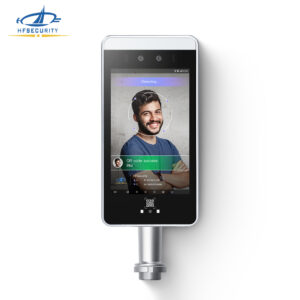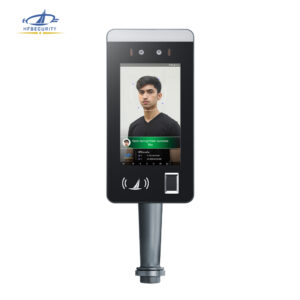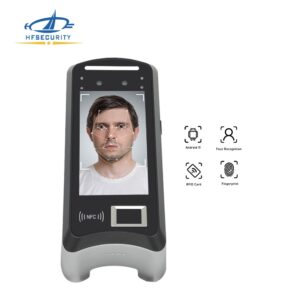How Real-Time Facial Recognition Attendance Systems Work
Real-time facial recognition attendance systems integrate advanced technologies such as AI, machine learning, and computer vision to verify identities and track attendance with high accuracy. These systems capture facial features in real-time, comparing them to stored data for seamless and secure attendance management, ensuring quick and efficient processing for both employees and organizations.
1.Face Detection
Algorithms like MTCNN (Multi-Task Cascaded Convolutional Networks) play a crucial role in detecting faces within video streams or images. The MTCNN algorithm works through a multi-stage process, where it first identifies candidate face regions within an image, then refines the detection by analyzing facial landmarks such as the eyes, nose, and mouth. These landmarks allow the system to precisely locate and align the face in different orientations and lighting conditions. MTCNN excels in handling variations in facial poses, partial occlusions, and low-resolution images, making it a reliable tool for accurate facial recognition in real-time attendance systems.
2.Feature Extraction
Models like FaceNet convert detected faces into unique numerical vectors, called embeddings, by mapping facial features into a high-dimensional space. Each vector captures distinct characteristics, such as the distance between eyes, nose shape, and overall facial structure. These embeddings are then compared against a pre-registered database to identify individuals. The system can accurately recognize faces even under varying conditions like different angles, lighting, or facial expressions, ensuring efficient and precise identification.
3.Matching and Verification
The system calculates the similarity between live captures and stored templates by comparing their embeddings. This is typically done using distance metrics like cosine similarity or Euclidean distance, which measure how close two vectors are in the high-dimensional space. Cosine similarity evaluates the angle between vectors, while Euclidean distance calculates the straight-line distance between them. Both methods enable the system to determine whether a live capture matches a stored template, ensuring accurate and efficient identity verification.
4.Real-Time Processing
Optimized algorithms combined with powerful hardware—such as NVIDIA Jetson edge computing devices—enable real-time facial recognition with minimal latency. These systems process data directly at the edge, reducing the need for cloud transmission and ensuring fast, responsive performance. This architecture allows instant identity verification, even in high-traffic environments like office buildings, factories, or public transportation hubs, where speed and accuracy are critical. As a result, organizations benefit from improved user experience, reduced wait times, and enhanced operational efficiency.
For example, the AttenFace system uses periodic snapshots (e.g., every 10 minutes) to track attendance in classrooms, ensuring students remain present for a minimum duration.
Features of real-time facial attendance
1.Enhanced Accuracy and Fraud Prevention
Facial biometrics eliminates “buddy punching” by binding attendance records directly to each employee’s unique facial features, ensuring only the authorized person can check in. This enhances security and accuracy in workforce management.
Advanced anti-spoofing techniques in facial biometric systems—such as RGBD sensors, which combine color and depth data, and Cross Modal Focal Loss (CMFL)—help accurately detect and prevent spoofing attempts. These technologies identify 3D masks, printed photos, or video replays by analyzing depth discrepancies and subtle facial dynamics. By distinguishing real faces from fakes, they ensure high security and reliability, making the system robust against identity fraud in sensitive applications like access control or attendance tracking.
2.Improved Efficiency
Time attendance systems reduce manual administrative work by automatically recording employee check-ins and check-outs. These systems sync seamlessly with payroll software, minimizing errors, saving HR time, and improving overall efficiency in workforce management.
Systems like Recursive Minimum Window (RMW) optimize face tracking in crowded scenes by rapidly locating and isolating multiple faces. This enables accurate multi-person facial recognition and verification within just 3 seconds, ensuring fast and efficient identity checks in busy environments.
3.User-Friendly Experience
Facial time attendance systems offer contactless operation, enhancing hygiene while simplifying the check-in process. Employees can clock in with just a glance, reducing queues and physical contact, making the system ideal for modern, health-conscious workplaces.
Time attendance systems with mobile compatibility let employees check their attendance records anytime, anywhere. Real-time access enhances transparency, empowers staff, and streamlines HR communication, making workforce management more efficient and user-friendly.
4.Scalability
Face time attendance systems with modular designs—such as AttenFace’s independent face recognition server—allow seamless integration with existing platforms like Moodle, ERP, or enterprise HR systems. This flexibility ensures organizations can upgrade to advanced biometric attendance solutions without overhauling current infrastructure, reducing costs and implementation time while enhancing functionality.
Facial Attendance Application Scenarios
1.Facial Recognition Attendance in Enterprise Applications
Facial recognition attendance systems are increasingly adopted by enterprises to streamline workforce management and enhance security. These systems use advanced computer vision and AI algorithms to capture and analyze unique facial features. Once an employee’s face is registered in the system, real-time cameras at entry points identify individuals by comparing live images with stored templates using facial embeddings and similarity metrics like cosine distance.
طلب
Access Control & Attendance: Employees simply walk past the camera to clock in or out, making the process seamless and contactless.
Workforce Monitoring: HR departments can track punctuality, shift patterns, and absenteeism through centralized dashboards.
Integration: These systems can be integrated with payroll, ERP, and HRMS platforms to automate time tracking and compensation.
Key Advantages
Accuracy: Reduces errors associated with manual or card-based systems.
Security: Eliminates “buddy punching” by verifying identity with biometric data.
Convenience: Contactless and fast, ideal for high-traffic environments.
Efficiency: Saves HR time and ensures real-time data synchronization.
Scalability: Suitable for businesses of all sizes—from small teams to large enterprises.
2.Facial Recognition Attendance for Farm Workers
طلب
Farm workers are registered in the system with their facial data. Each day, they clock in and out by standing in front of a facial recognition terminal or mobile device equipped with a camera. The system captures a live image, extracts facial landmarks, and compares it to the stored database using algorithms like FaceNet or MTCNN. Verification is completed in seconds, even in outdoor conditions.
Key Advantages
Accurate Attendance Tracking: Prevents time fraud such as “buddy punching,” ensuring that only registered workers are recorded.
Contactless and Fast: Ideal for outdoor settings where cards or fingerprint devices may be impractical due to dirt or gloves.
Mobile-Friendly Deployment: Systems can run on portable devices, allowing use in fields, packing areas, and greenhouses.
Labor Cost Control: Automatically logs working hours and integrates with payroll systems, reducing manual calculations.
Improved Productivity Monitoring: Enables managers to analyze attendance trends and workforce efficiency.
Facial recognition provides a smart, efficient, and hygienic attendance solution tailored for agricultural environments—helping farms manage large labor forces with ease and accuracy.
3.Facial Recognition Attendance for School Management and Parent Monitoring
Facial recognition attendance systems are increasingly being adopted by schools to streamline student attendance tracking and enhance parent communication. These systems use advanced AI and computer vision to identify students by analyzing their unique facial features, offering a secure and efficient way to monitor attendance and improve overall school management.
Students are registered in the system by capturing their facial data at the start of the school year. On a daily basis, students simply walk past the facial recognition terminal to clock in when entering the school or attending class. The system captures a live image, compares it to the stored facial template using algorithms like FaceNet, and verifies their identity in real-time.
Advantages for School Management and Parents
Accurate Attendance: Ensures precise attendance tracking by preventing issues like proxy attendance or skipping classes.
زيادة الأمن: Enhances school security by verifying students’ identities, reducing unauthorized access or visitor entry.
Convenience and Speed: Reduces long queues or disruptions during roll calls, allowing students to check in quickly without needing physical cards or signatures.
Real-time Notifications for Parents: Parents receive immediate alerts via mobile apps when their child arrives at school or attends classes, improving communication and peace of mind.
Compliance and Reporting: The system automatically generates detailed attendance reports, assisting with regulatory compliance and educational audits.
Hygiene and Safety: As a contactless solution, facial recognition supports health standards by minimizing physical interaction during check-ins.
Facial recognition attendance systems are transforming how schools manage attendance and engage with parents, offering a more secure, efficient, and transparent way to monitor student presence and communication.
Challenges and Solutions
1.Environmental Factors
Challenge
Lighting variations, facial angles, and motion blur can significantly reduce the accuracy of real-time facial recognition attendance systems, making it difficult to achieve consistent results in different environments and during fast movements.
حل
Multi-angle sampling captures faces from diverse orientations during registration, ensuring the system can recognize individuals from various perspectives. This approach enhances recognition robustness, allowing for accurate identification even under challenging conditions such as varying lighting or slight motion.
2.Privacy Concerns
Challenge
Storing biometric data raises privacy risks, as sensitive personal information like facial features may be vulnerable to breaches, increasing concerns regarding unauthorized access or misuse of data.
حل
Encrypted templates (not raw images) and compliance with GDPR/CCPA ensure data protection by securely storing only encrypted biometric data. This approach mitigates privacy risks, providing users with confidence that their personal information is safeguarded in accordance with global data protection standards.
3.Computational Demands
Challenge
Real-time processing requires high computing power, particularly in environments with large volumes of data or high user traffic. This can lead to delays, system overload, and hinder the performance of real-time facial recognition systems.
حل
Edge computing devices (e.g., NVIDIA Jetson) and optimized algorithms like RMW reduce latency by processing data locally, near the source, rather than relying solely on cloud servers. This ensures faster response times, lower bandwidth usage, and enhanced system efficiency in high-traffic environments.
الاتجاهات المستقبلية
1.AI-Driven Enhancements
Video Face Restoration
Techniques like PGTFormer enhance facial recognition accuracy by restoring low-quality or blurred video frames in real time, ensuring reliable identification even in low-resolution or motion-heavy environments.
Federated Learning
Facial recognition systems using federated learning enable decentralized training of AI models while preserving user privacy, as data stays on local devices, reducing the risk of data breaches and ensuring compliance with privacy regulations.
2.Integration with IoT
Facial attendance control systems will benefit from smart cameras and sensors that enable seamless integration with building access systems and smart locks. This creates a unified, automated solution for managing both attendance and secure access, enhancing safety and operational efficiency.
3.Ethical AI Frameworks
Facial attendance control systems are evolving to include transparent algorithms and robust bias mitigation strategies. These advancements aim to ensure fairness and accuracy across diverse populations, addressing ethical concerns and promoting inclusive technology adoption in various organizational settings.
خاتمة
Real-time facial recognition attendance systems are transforming how organizations manage workforce productivity and security. By addressing challenges like environmental variability and privacy risks, these systems offer scalable, efficient, and user-centric solutions. As AI continues to evolve, expect even greater accuracy and integration capabilities, making facial recognition the gold standard for modern attendance management.
Optimize your operations today with a real-time facial recognition attendance system tailored to your needs!





